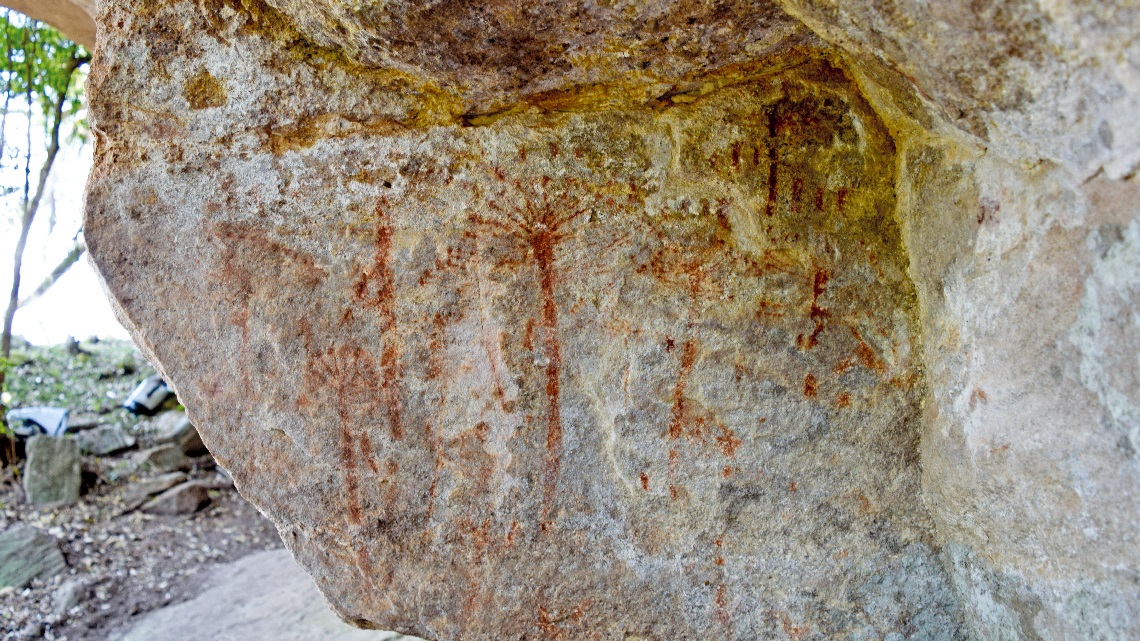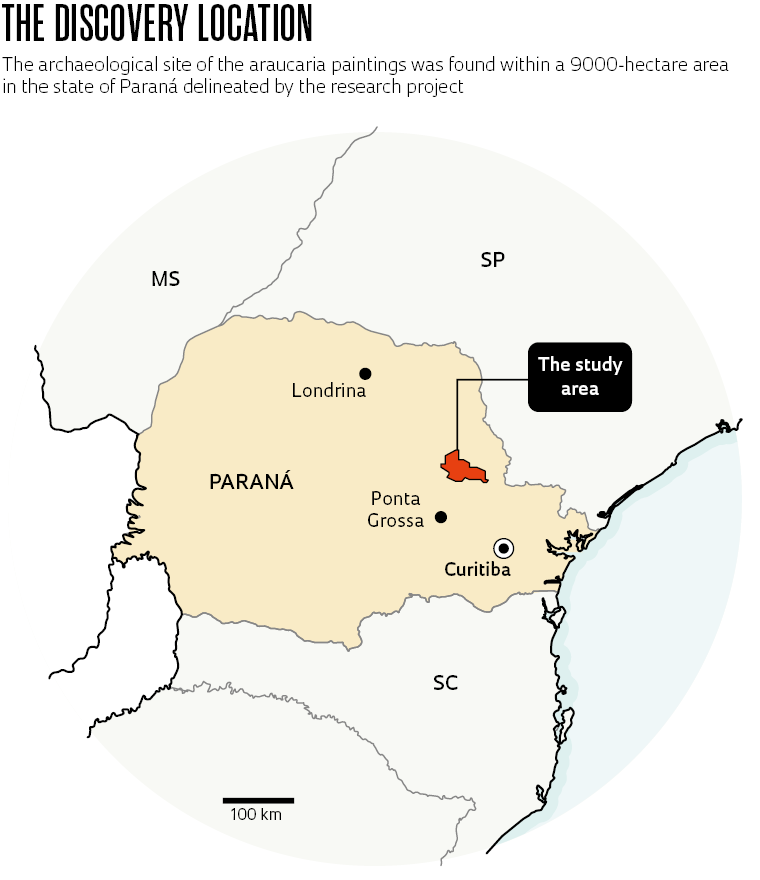On a hillside near the Piraí-Mirim River, about 180 kilometers northwest of Curitiba, a forward-leaning, sandstone wall formed a series of shelters under the overhanging rock. This type of natural cavity creates at its base a semi-closed area, relatively protected from the weather, where traces of human occupation from the remote past are often found.
In one of these shelters, discovered in 2021 in a rural area of Piraí do Sul, a municipality that takes its name from the same river, a panel less than half a square meter in size portrays a scene that resembles a small grove of araucaria trees.
According to a study published in the magazine Caderno de Geografia in early February, this painting could be the first known rock art representation in Brazil of the tree species Araucaria angustifolia, popularly named araucaria, sometimes also called Paraná pine, or Brazilian pine.
Described in the literature in 1820, A. angustifolia grows in highland regions with a temperate climate, especially in the three southern Brazilian states. The new archaeological site in Paraná is in a region just over 1,100 meters above sea level and provides ample habitat for the species. Araucaria is also found in the mountainous areas near the border of São Paulo, Rio de Janeiro, and Minas Gerais, and, less abundantly, in parts of Argentina and Paraguay. The species, which is threatened with extinction, can live 200 years and reach 50 meters in height.
Faded or partially erased by the humid conditions, the cave painting features 13 araucarias, with their typical rectilinear trunks and umbrella- or cone-shaped crowns, and 20 figures with anthropomorphic shapes that resemble human beings. Some of the trees appear to be being climbed by a person or perhaps an arboreal primate. The ascending movement is easily defended: the araucaria’s seeds (pine nuts) are found in the cones located at the tops of the trees and are a food source for Indigenous peoples, as well as animals.
“The painting is all one piece and shows larger and smaller araucarias that seem to represent old and young specimens,” says geographer Henrique Simão Pontes, from the University Group for Speleological Research at the State University of Ponta Grossa (GUPE-UEPG), the study’s lead author. “Our hypothesis is that the panel was painted by ancient members of Indigenous peoples of the Jê linguistic branch.”
In addition to the design of the small forest of Paraná pines, another 24 panels with paintings made using reddish and black pigments were found along the 16.4-meter continuous surface of the wall that forms the Abrigo das Araucárias (Araucaria shelter), as the archaeological site has been named. “Most of the graphics are geometric designs,” comments geographer and tour guide Alessandro Giulliano Chagas Silva, from GUPE, who is one of the coauthors of the archaeological discovery. “We didn’t find any other drawings with araucaria.” The paintings, whose state of conservation varies considerably, contain fingerprints, dots, geometric shapes, and drawings depicting plants.
There is no estimate of when the images were produced. Excavations have not yet been carried out at the archaeological site but are planned for another research project. There are no longer Indigenous peoples living near the cave shelter. However, before the arrival of European explorers at the beginning of the sixteenth century, this area of Paraná was part of a large swath of territory in Southern Brazil that was inhabited by peoples from the Jê linguistic branch, from which the current Kaingang and Xokleng ethnic groups descend.
Archaeologist Rafael Corteletti, from the Federal University of Pelotas (UFPel), in Rio Grande do Sul, also considers it likely that Jê people created the painting of araucaria trees, one of the symbols associated with the state of Paraná. “I don’t know of any other type of rock art or archaeological graphics related to araucarias. That’s why this site has a special significance,” comments Corteletti, who did not participate in the study. “I would say it’s possible that the paintings were made by the Kaingang ethnic group. As the site was not excavated by the team that made the discovery, we don’t have other associated materials, or even an established chronology, to reinforce the hypothesis of authorship attributed to the Jê. To be sure, it will be necessary to look for other elements of their material culture.”
The Abrigo das Araucárias was one of 29 archaeological sites discovered since July 2021 by the EspeleoPiraí project, coordinated by members of GUPE. The initiative looked for caves and shelters that could be of speleological or archaeological interest within a 9,000-hectare area in the Campos Gerais region of Paraná. According to Pontes, more than a hundred caves have been identified in this region, 36 of which feature cave paintings, generally composed of geometric designs and representations of human figures, animals, and sometimes, plants such as corn. Now, the figures of the Araucaria trees scratched on the hillside’s rocks have been added to these records.
Scientific article
PONTES. H. S. et al. First rupestrian representations of Araucaria angustifolia in Southern Brazil. Caderno de Geografia. Vol. 33, no. 72. Jan.–Mar. 2023.
Republish
